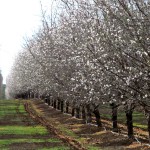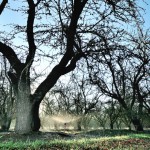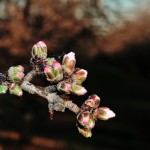|
Northern California – February 3, 2014This report covers observations and conditions just prior to the start of the 2014 bloom. The next scheduled report will be posted on Friday, February 7, 2104. We anticipate posting the first of the daily Bloom Reports on February 10, 2014. Taken along the west side of the Sacramento Valley, this report’s photos for the northern region present an over-the-top view of an orchard showing the advanced development of the Sonora and a down-the-row shot of the Price and Sonora, both in Glenn County, Our final image provides a view of the Nonpareil and Winters in Colusa County
The geographic location of the Sacramento Valley has provided little advantage over the San Joaquin Valley when considering the total rainfall the region has received. Dry conditions have dominated the region’s weather, forcing growers to provide supplemental water where it has been available. Growers who receive their water from the federal Central Valley Project have been informed that they will receive no water this year, even though they do not have to contend with trans-delta conveyance issues that limit movement of water to the San Joaquin Valley. Deliveries from the State Water Project are a bit more complicated. Sources have stated that contractors with superior rights may be able to receive a portion of their contracted amounts while others with inferior rights will receive no water. Observers have reported that well drillers have been working through the winter months, producing new wells and reconditioning older ones as growers work to develop alternative supplies of water.
Growers have spent the winter months preparing their orchards. Pruning operations and brush shredding have proceeded with little difficulty and growers have been able to freely complete applications of soil amendments and dormant season disease management treatments. As previously noted, while the lack of moisture has limited weed growth, growers will be forced to employ alternative weed control measures during the growing season in order to maintain weed-free tree rows into the harvest. The normally used herbicide materials require some degree of rainfall in order to be effective on the soil surface and the absence of adequate rainfall has eliminated their use this year. |
Central California – February 3, 2014
| This report covers observations and conditions just prior to the start of the 2014 bloom. The next scheduled report will be posted on Friday, February 7, 2104. We anticipate posting the first of the daily Bloom Reports on February 10, 2014.
Today’s photos for the central region show an early morning irrigation west of Salida and the buds of the early-blooming Avalon variety in their transition into the pink tip stage west of Grayson. Record breaking dry conditions have dominated the weather in the northern San Joaquin Valley. Up until January 30th, when a fast moving low pressure system passed over the state, dropping between 0.4 to 0.8 inches of precipitation, growers had endured over 50 days without rainfall. Following a period of very cold temperatures when morning lows dipped in the low and middle 20’s for much of December, unseasonably warm conditions during January have driven daily maximum temperatures into the upper 60’s and lower 70’s, further antagonizing the lack of rainfall in the region. As shown in the third photo accompanying this report, the annual transformation from the dormant season into the bloom has begun. Early blooming varieties such as the Avalon and Sonora are predominately in the green tip stage, with advanced examples, primarily along the I-5 corridor on the west side of the region also moving into the pink tip stage. Observers have reported finding a few “rogue” open flowers visible in the Sonora, and while the Nonpareil and California type varieties are swelling, they remain overwhelmingly in the dormant stage. Throughout the region, beekeepers can be found moving hives into the orchards in anticipation of the start of the bloom.
Growers have spent the winter of 2013/14 preparing for the upcoming bloom. While the lack of rain has provided unimpeded opportunities to enter the orchards, the absence of moisture has also hindered several operations. Mummy shaking, the removal of nuts that failed to fall from the trees during the 2013 harvest is best accomplished during rainy, foggy conditions that help loosen the nuts. Applications of soil applied herbicides needed to keep the tree rows free of weeds during the growing season also need rainfall to be incorporated into the soil surface. As a result, growers will be forced to employ alternative methods to control Navel Orange Worm and weed growth during the upcoming growing season; methods that may be more costly and less effective. Growers have also been planting new orchards and placing replant trees in existing orchards. Many have also completed applications of lime or gypsum, as needed to correct soil pH levels and to combat the accumulation of salts in the orchard root zones. Pruning operations and brush shredding on producing orchards has been completed in almost all plantings. However, many year-old plantings have yet to receive their first pruning/training. Irrigation has also been a focal point. The lack of rain has forced growers with water available from private wells to supplement the moisture levels within their orchards, while those who rely solely on “surface water” are waiting for the deliveries from their local irrigation districts. Unfortunately, depending on the grower’s location, water from those districts may be in very short supply. Those drawing water from the federal Central Valley Project, CVP, have been informed that they will be receiving no water this year. Deliveries from the CVP were set at 20% of their contracted amounts last year and have ranged from 20% to 50% in recent years. The State Water Project, SWP, also announced last week that deliveries to their contractors have reduced from 5% to zero. Growers are awaiting announcements from their local districts. While some producers are anticipating that they may have enough water to fulfill most of their needs, rumors of severe cutbacks are circulating around the region. Obviously, growers have been working to secure alternative water supplies. Well drillers have been busy producing new wells and reconditioning older wells. And growers have been seeking opportunities to purchase water where it is available. |
Southern California – February 3, 2014
| This report covers observations and conditions just prior to the start of the 2014 bloom. The next scheduled report will be posted on Friday, February 7, 2104. We anticipate posting the first of the daily Bloom Reports on February 10, 2014.
This report’s photos for the southern region show the first bloom of the Sonora in Kern County, followed by the swelling dormant buds of the Aldrich and pallet of hives placed in an orchard in Madera County. The extended period of dry weather has dominated grower’s thoughts in the southern San Joaquin Valley during the winter of 2013/14. Growers in the region endured in excess of 50 days without rain, leading to very dry soil profiles, nearly non-existent snowpack levels in the Sierra Nevada watershed and depleted reservoirs throughout the state. With the arrival of a fast-moving weather system during the final week of January, rain finally returned to the region on January 30th. However, total precipitation levels were held to no more than 0.3 inch, with greatest amounts reported in the region’s northern counties. While December’s weather was dominated by very cold temperatures, when morning lows dropped consistently in the low and mid 20’s and even occasionally into the upper teens, January was dominated by unseasonably warm temperatures, created by the high pressure area that blocked storms from the state. Daytime highs during much of January ranged from mid and upper 60’s to low to mid 70’s, driving bud development in the region’s orchards and aggravating the dry conditions.
As may be seen in the photos accompanying this report, the first stages of the 2014 bloom are becoming evident in the southern San Joaquin Valley. Observers are reporting that the early-blooming Sonora variety is moving into the green tip stage, with a few “rogue” flowers also making their appearance in advanced plantings in Madera County. The balance of the region’s varieties are found in the dormant stage, albeit quite swollen and poised to begin their evolution into bloom. In anticipation of the bloom, beekeepers can be seen delivering hives to the orchards in all areas of the region. The dry conditions that dominated the region’s weather over the past few months have provided plenty of opportunity for growers to work within their orchards. However, the dearth of moisture has also made some operations difficult, if not impossible. As an example, observers are reporting that many orchards around the region have an excessive number of mummy nuts remaining in the trees. These nuts, which failed to fall from the trees during the 2013 harvest, can act as a safe-harbor for overwintering Navel Orange Worm if not shaken from the trees, swept into windrows and destroyed by flail mowers during the dormant season. As a result, treatments during the growing season to control this serious pest will become more critical.
Irrigation has been a prime focus during the winter, owing to the dramatically low snowpack and reservoir levels. Many growers have been forced to provide supplemental water to their orchards from privately owned deep wells and all in the region are concerned about the prospect of significant curtailments in deliveries of “surface water” during the upcoming growing season. Both the federal Central Valley Project, CVP, and the State Water project have informed their contractors that they will not receive any water this year. The Bureau of Reclamation, administrator of the CVP system has announced that growers who “banked” or saved water from last year’s irrigation season in the state’s reservoirs will be able draw that water for use on their farms. Following the announcement of the drought emergency by Governor Brown, growers were concerned that the water that they had purchased and banked would be taken for alternative uses. Growers faced with reduced supplies are all working to secure alternative water supplies where possible. |

 Abnormally dry conditions have dominated the winter months in the Sacramento Valley, resulting in record low water levels in the Sierra Nevada snowpack as well as in the state’s system of reservoirs. Temperatures during the winter months have been quite diverse. Much of December was dominated by very cold temperatures, with morning minimum readings dropping into the low and mid 20’s for approximately two weeks. January, however, provided quite a contrast, with daily maximum readings ranging between the mid and upper 60’s to lower 70’s for much of the month, driving bud development throughout the region. The extended period of dry weather, which lasted in excess of 50 rain-free days, was finally broken with the arrival of a fast moving weather system that passed through the state on January 29th and 30th. Rainfall was a bit on the sparse side, however, with total precipitation levels ranging from 0.25 to 0.5 inch. Additional amounts were reported in isolated areas, dropped by thunderstorms that roamed through the southern areas of the region.
Abnormally dry conditions have dominated the winter months in the Sacramento Valley, resulting in record low water levels in the Sierra Nevada snowpack as well as in the state’s system of reservoirs. Temperatures during the winter months have been quite diverse. Much of December was dominated by very cold temperatures, with morning minimum readings dropping into the low and mid 20’s for approximately two weeks. January, however, provided quite a contrast, with daily maximum readings ranging between the mid and upper 60’s to lower 70’s for much of the month, driving bud development throughout the region. The extended period of dry weather, which lasted in excess of 50 rain-free days, was finally broken with the arrival of a fast moving weather system that passed through the state on January 29th and 30th. Rainfall was a bit on the sparse side, however, with total precipitation levels ranging from 0.25 to 0.5 inch. Additional amounts were reported in isolated areas, dropped by thunderstorms that roamed through the southern areas of the region. As shown in the photos accompanying this report, the 2014 bloom in the Sacramento Valley is getting under way… at least in the most advanced areas of the region. Observers are reporting that orchards on the west side of the Sacramento Valley, along and generally west of I-5 are running ahead of the balance of the region. The early blooming Sonora and Winters varieties along the west side are currently presenting an average of approximately 5% of their flowers for pollination, with the most advanced orchards having as much as 35% of their flowers open and available. While the varieties in some plantings appear to be fairly well synchronized, others are exhibiting a greater degree of variation. Observers have also noted some variation within orchards on foothill soils, with trees at the top of the hills running ahead of those in the lower elevations. Further, orchards on sandy soils and those that experienced a high degree of moisture stress last year are also running ahead of other plantings. Meanwhile, in the remainder of the region, observers have noted that the pace of development is running significantly behind the west side, with the Sonora presenting only a trace amount of open flowers. Bees have been very active within the orchards having open flowers. Beekeepers have been moving colonies into the orchards for about two weeks and the poor rainfall the region have received this year has resulted in very little weed growth in and around the orchards. This also means that there are very few flowers available for the bees to forage upon until the bloom begins in earnest.
As shown in the photos accompanying this report, the 2014 bloom in the Sacramento Valley is getting under way… at least in the most advanced areas of the region. Observers are reporting that orchards on the west side of the Sacramento Valley, along and generally west of I-5 are running ahead of the balance of the region. The early blooming Sonora and Winters varieties along the west side are currently presenting an average of approximately 5% of their flowers for pollination, with the most advanced orchards having as much as 35% of their flowers open and available. While the varieties in some plantings appear to be fairly well synchronized, others are exhibiting a greater degree of variation. Observers have also noted some variation within orchards on foothill soils, with trees at the top of the hills running ahead of those in the lower elevations. Further, orchards on sandy soils and those that experienced a high degree of moisture stress last year are also running ahead of other plantings. Meanwhile, in the remainder of the region, observers have noted that the pace of development is running significantly behind the west side, with the Sonora presenting only a trace amount of open flowers. Bees have been very active within the orchards having open flowers. Beekeepers have been moving colonies into the orchards for about two weeks and the poor rainfall the region have received this year has resulted in very little weed growth in and around the orchards. This also means that there are very few flowers available for the bees to forage upon until the bloom begins in earnest.



